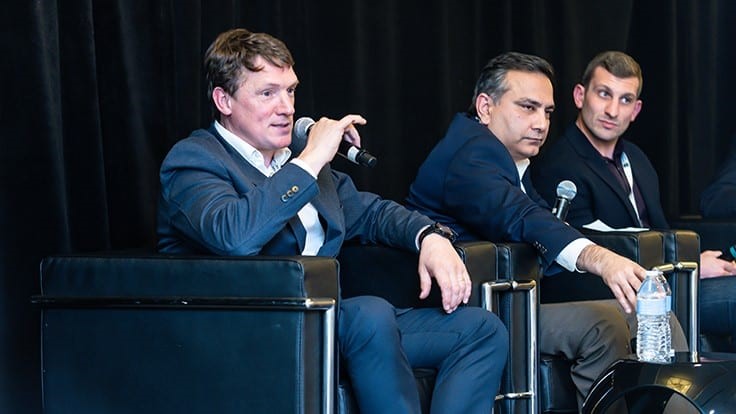The latest fleet and container technology is giving waste companies the data they need to revolutionize the way waste is collected and processed. Similarly, a range of back office technology is helping companies improve their efficiency and increase their productivity.
At Waste Today’s Corporate Growth Conference, which took place Nov. 18-19 in Chicago, a group of industry leaders discussed the some of today’s most interesting tech solutions in a session titled, “Tech on the Street (And in the Back Office)”. Led by moderator Michael Hoffman, managing director at Stifel, the panel consisted of AMCS Group CEO Jimmy Martin, Dover Corporation SVP and Chief Digital Officer Girish Juneja and Compology CEO Jason Gates.
Stopping the bleeding
According to the panel, while there has been an uptick in industry investment in technology in the waste sector, there is still room for more integration.
“I do think the waste industry is under-invested in technology compared to [norms in other industries]. We’re averaging probably somewhere in the region of 1 percent a year spend on technology,” Martin says. “The average should probably be closer to 2 to 2.5 percent of revenues. So, I think we’re still well under-spending in that area. … I think the opportunity is massive. When you look at what we can do with the data, I think you can begin to understand how we can use information to make better lead-time decisions around optimizing collection, offering service on demand and improving how we interact with customers and how haulers interact with one another.”
Martin says that he estimates waste companies experience revenue leakage in the range of 5 to 7 percent on average, and that better tech tools can help decrease these losses.
Juneja agreed, saying that by adopting technology, haulers can begin to better integrate their businesses in a way that allows them to pinpoint, and then eliminate, inefficiencies.
“For the hauler, the cost of collection is broken in various parts,” Juneja says. “It’s broken all the way upfront from the driver, the capital investment, the cost of hauling, the cost of disposal, and there are other costs involved. Once you break those costs out of the silos they sit in and you figure out the inefficiencies that exist at each point of that cost transition, and then you look at how can you fill those gaps digitally so that the gaps don’t exist, there is a significant opportunity there for the haulers today.”
Getting a return
According to Gates, technology can be implemented throughout a company’s operations to mitigate costs. This includes disposal and labor—two areas many perceive as representing fixed expenses.
“I was having some conversations earlier today about the notion that there are a couple costs that no one has any control over changing—disposal and labor. I think the myth that I want to bust is that by using technology, there’s actually a real opportunity to totally change the cost structure around those two items. Disposal is a great example: By better understanding the material streams that you’re picking up and best matching the material stream with the location where it should be disposed of, that provides a huge opportunity for controlling costs and improving margin on each load.”
Gates says that through tools such as container monitoring technology, companies can weigh containers before they’re picked up to better price each load. He says that this monitoring technology can even gauge what material is in a container before a truck is dispatched. This allows trucks to transition from what would be a recycling route to a landfill garbage route if there is too much contamination, allowing haulers to avoid the cost of disposal stemming from taking contaminated material to a MRF.
From an inventory perspective, Gates says that haulers overestimate the number of containers they have by roughly 30 percent because they don’t know where their assets are. While roll-off inventory is most prone to be misunderstood, Gates says, this also holds true for companies keeping track of dumpsters. He notes that having monitoring technology on these containers can help eliminate lost assets and lead to more detailed information regarding container contents.
Beyond container monitoring tech, Juneja says that the fleet innovations are also contributing to better pricing strategies and reduced costs. Thanks to things like onboard cameras and fleet monitoring service, haulers can detect and document issues in real time. He gives an example of a hauler dealing with an overfilled container. With fleet software able to take a picture of the container and weigh its contents, customers can be billed appropriately. With this data in hand, companies can also talk to their customers about potentially upgrading to a bigger container if necessary. The goal, Juneja says, is to use this information to better cater to variances within a hauler’s customer base.
Martin noted that a glimpse overseas helps paint the picture of how these monitoring solutions can help streamline a company’s operations. He says that AMCS has approximately 10,000 trucks in countries like Ireland, Norway and Sweden where every vehicle has RFID, weighing and camera technology.
“Every container is weighed, RFID-validated the GPS coordinates are validated in real time to [ensure] that the customer has paid their bill. And if there’s contamination in the container, a picture is taken and it’s automatically stopped on collection,” Martin says.
Martin says that automation not only has the potential to change how haulers operate, it can also improve and personalize the service offerings of customers.
“Instead of dealing with a sales team, your commercial customer [will be able to go] online, pick from a menu of what collection service he wants based on his day, his location and the waste types in the waste stream,” he says. “He’ll have his price customized because [your back office] software understands where that customer is, understands your assets and understands what the best collection method for that customer is.”
Martin says that between greater fleet efficiencies, automation leading to fewer resources being needed for customer engagement, and overall streamlining of operations, companies can see a return on investment (ROI) within 6 months.
While the ROI is tangible, Martin went on to say that companies need to be willing to take the time and effort to put the proper organizational structure in place to best utilize these tools.
“You cannot apply this type of technology without changing your business, right?” he says. “You can’t have the same business practices and the same operations. So, that’s probably the biggest challenge.”
Tackling recycling
The issue of recycling is one that is front and center in the industry right now. According to the panel, new tech solutions can help address the problem of contamination at the source.
“In some markets, we have a weighing system on every truck,” Martin says. “Every time a container is being picked up, it’s being weighed. We know if a recycling container is more than 30 pounds, there is probably waste in there. And we can send that for an audit automatically and get pictures taken [so the customer can be disciplined] or fined if necessary.”
He says this information can help inform community education efforts aimed at specific issues. Gates piggybacked on this sentiment, saying that container monitoring software is helping companies be more targeted in their messaging.
“I think something that’s really important is the way in which the message is delivered,” he says. “The status quo is being able to deliver a paper pamphlet or a generic message that says, ‘recycle more, recycle better.’ And the way the technology is trending is now highly customized messaging. The same way that you might receive highly targeted messaging from a shopping website, we can now deliver emails and text messages that are specific to a business location, their behaviors and give them specific instructions to say, ‘Don’t put this specific material in the containers, which usually occurs between 7 and 10 p.m., for example.’”
Gates says that this specificity doesn’t just help haulers with accountability, it can help justify pricing strategies.
“I think for the layman, when there are continuous price increases, it’s difficult for consumers to understand why,” he says. “We’ve heard of customers getting price increases of up to 18 percent in one year after receiving price increases of 7 and 8 percent in the previous year. I think what technology does is really enable waste companies to provide a value-add above what they’re currently doing and justify outside price increases.”
Making the switch
While new technology can improve every phase of a waste company’s operations, the decision to buy in must start at the top.
“I think [the push for technology] has to be driven at the CEO level,” Martin says. “Any operator in this new day and age has to have a technology plan that is more than [just looking a year down the road]. It’s a strategy you have to think about over 5 or 6 years or more. You have to look that far ahead, and it’s critical that your investments tie together. I have seen a lot of ‘false dawns’ based off of people investing in bits of this and that technology and none of these solutions being tied together. When this happens, the the long-term value doesn’t get [realized]. It’s really important you think strategically about your investments and that you make sure these decisions align with the strategic direction you are trying to move to in the longer term.”
Once the decision has been made to deploy these types of technologies, Gates says that haulers should work with service providers to roll out their solutions in a way that has maximum impact.
“We found the best results are when our clients are open to us providing recommendations on how to best implement technology,” he says. “In fact, when we look at demonstrating ROI and evaluating technology, the customers who are willing to share their financial reporting with us and that allow us to help with the analysis on how the technology is impacting their business, are the ones who we’re having the most success with. I think coming to the table with that open mind … is a critically important step in the process.”
















